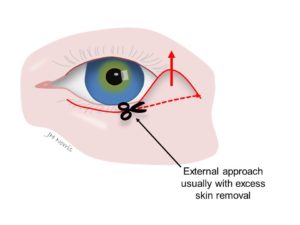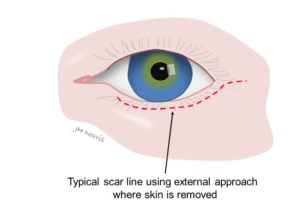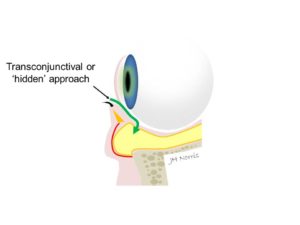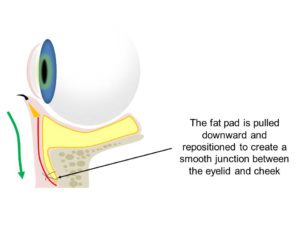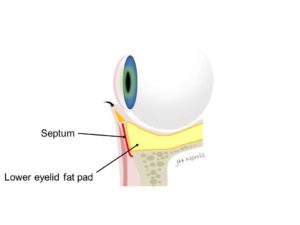
With age this wall can lose its tone and expand allowing the fat that sits behind it to slip forward. This is known as ‘fat prolapse.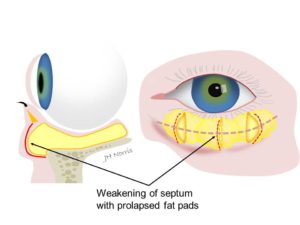
The second reason for eye bags is an excess of lower eyelid skin.
Skin tightening: This involves an incision placed just beneath the eyelashes that extends past the outer corner of the lower eyelid. Excess skin can be removed and stitches are placed along the course of the incision line.
Fat removal or repositioning
The lower eyelid fat can become prominent as the eyelid ages. This can give rise to ‘bags’ which can be reduced.
This can be performed through a skin incision described above (when undergoing simultaneous eyelid tightening). This can also be performed through an incision on the inside of the eyelid (conjunctival approach) when no skin tightening is required.
Depending on each individual the lower eyelid fat can be repositioned to give a ‘smoother’ appearance to the eyelid or removed.
Mr Norris will often use a stitch to stabilise the outer corner of the lower eyelid to prevent any problems with the eyelid retracting after the surgery.
We usually perform lower eyelid blepharoplasty surgery under local anaesthetic and we often give sedation at the same time. You also have the option of a full general anaesthetic if you would prefer.
The risks of surgery include postoperative bleeding, scarring to the eyelids and infection. We advise that you use an antibiotic ointment after the surgery (see below) to help reduce the risk of infection. The lower eyelid can be pulled downwards after the surgery (eyelid retraction) and this can give a dry and sore eye. Hence we are very cautious about the amount of skin we remove.
Occasionally we may under or over correct the amount of skin that we remove and this can result in a different appearance between the eyelids. Mr Norris can modify things if there is significant disparity, although fortunately this is not often required. Sometimes the scar line can be slightly irregular with occasional small white cysts forming. Most of these complications can be corrected if needs be with a second operation.
A condition known as chemosis can occur after this type of surgery. This results in fluid accumulating around the eye and results in redness and swelling of the eye. This is rare and usually resolves of its own accord but may take several weeks.
The most serious risk of any eyelid surgery performed is damage to your eyesight or double vision. Fortunately this risk is extremely rare.
The eyelids will be bruised after surgery and you may have some bloodstained tears which is quite normal initially. The bruising may take 2-3 weeks to fully settle.
You should avoid any strenuous activity including lifting heavy objects for a least two weeks and avoid swimming for three weeks after surgery.
You should avoid any strenuous activity including lifting heavy objects for at least two weeks and avoid swimming for three weeks after surgery.
We will give you some antibiotic ointment (usually Chloramphenicol) to apply to the wounds and to the eyes after the surgery to help protect against infection and to help lubricate the eyes for two weeks
We advise that you apply ice compresses to the eyelids after surgery for three times a day for 5 minutes each time. This is to help reduce the bruising.
We normally see you after surgery to check the position of the eyelid.
Usually patients are quite anxious after having surgery near their eyes and most problems do settle with time. Problems that require immediate attention are the onset of new double vision, loss of vision and pain that cannot be controlled with regular painkillers. In particular if the eyelid swells up and you cannot open your eye then this requires an urgent review.
Please refer to the emergency contact page (under the header ‘Contact’) if you need advice.
Author: Mr Jonathan Norris FRCOphth

